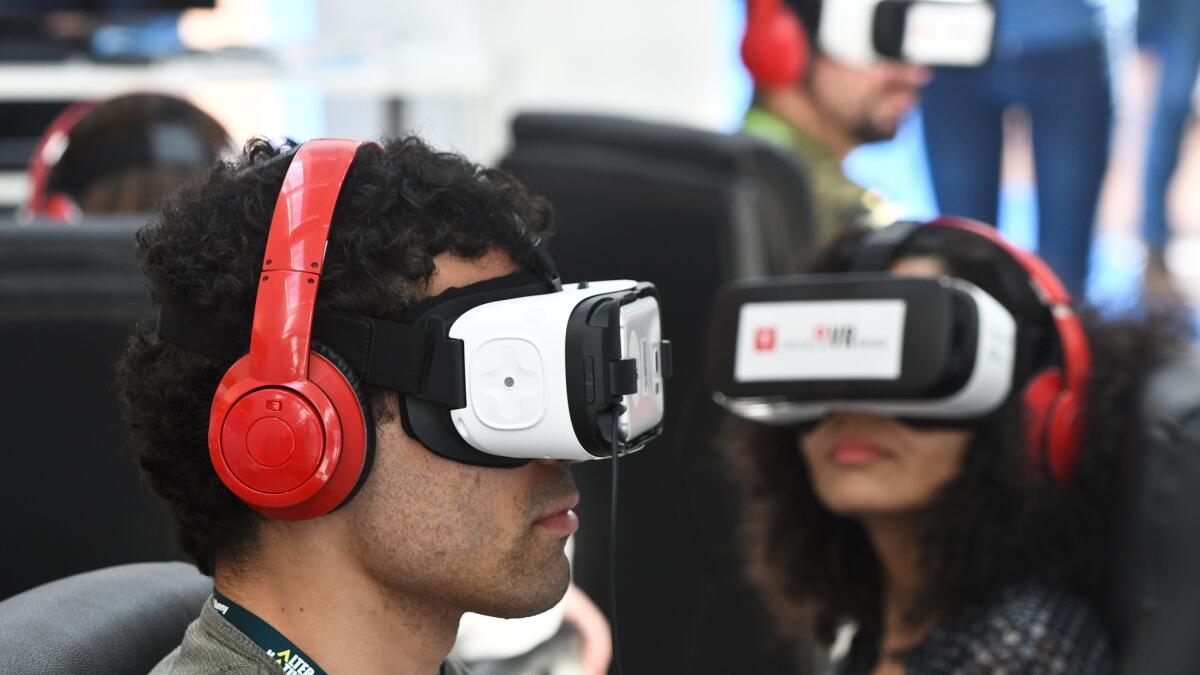Big Hollywood begins to place its chips on virtual reality — but is it a smart bet?

On a recent weekday, Hollywood director Ivan Reitman was in the bowels of Madame Tussauds wax museum here talking up an unlikely passion.
“VR is remarkable. What it does is force you to bring yourself into the story,” Reitman said, using the acronym for the immersive, headset-based viewing experience of virtual reality. “If you haven’t tried it, you just need 10 minutes with it to realize it’s an amazing experience.”
Reitman, the 69-year-old filmmaker behind such comedies as “Twins” and “Dave,” was not the most likely evangelist for the much-hyped new medium. But thanks to Sony’s “Ghostbusters: Dimension,” a tie-in to this weekend’s action-comedy flick and a shimmering new participatory VR experience he was helping launch, Reitman had become a convert — a symbol of a traditional entertainment business dipping its toe in new waters.
For several years, major studios and media companies have largely stood on the sidelines of VR, allowing tech giants such as Facebook-owned Oculus and Samsung to take the lead in the potentially groundbreaking medium. But mainstream Hollywood players are starting to embrace the technology, making a flurry of investments, hires and content deals.
In the last six weeks, the venture arms of entertainment players including Comcast, Fox and talent agency WME have poured at least $43 million into startup ventures, setting off a slow-motion scramble for the right VR play. Sony Pictures recently made history when it named Jake Zim the first VR czar at a major studio.
Specific goals can vary, but the overall mission is simple: Get in on the ground floor, financially or creatively, of a medium that one day could represent a chunk of entertainment revenue. VR content, these companies believe, will exist on their slates alongside the so-called flat-screen entertainment of films and TV shows.
“The question with VR is always a why now one,” said Michael Yang, managing director of Comcast Ventures. Yang’s company has invested in a host of VR firms, making the bulk of a nearly $7-million investment in the Montreal-based VR start-up Felix & Paul Studios and a $6-million investment in Baobab Studios, the entity co-founded by “Madagascar” director Eric Darnell. “We’re always searching for the next great computing platform, and VR is a very good suspect,” he added.
The issue is whether all this activity will help VR avoid the bubble that beset CD-ROM, 3-D and other media-world next-big-things that never panned out. And it more particularly raises the question of whether giant media companies, often late to the party when it comes to new tech, can themselves lead the charge. Whether VR will be as much of a player in so-called cinematic (that is, passive) entertainment as in the interactive space of gaming remains to be seen.
We’re always searching for the next great computing platform, and VR is a very good suspect.
— Michael Yang, managing director of Comcast Ventures
The uncertainty surrounding VR’s future hasn’t slowed deal-making.
“This is an interesting moment, with media companies making multiple investments in VR,” said Drew Larner, the COO of video director Chris Milk’s firm Within. “Certain companies like to sit back and wait,” he acknowledged. “But I think there are many that are smart and recognize what’s happening. It’s skin in the game, an opportunity.”
Within reaped the fruits of that interest last month when it garnered nearly $13 million in financing from the likes of Fox and WME. The company aims to use the money to expand its efforts to produce and distribute short-form VR content.
What the Hollywood firms hope to get out of virtual reality, meanwhile, is entree to a world from which they were previously shut out — in the studios’ case, eventually allowing them to finance and develop VR pieces as they do traditional content.
“A lot of this is education, for us and the filmmakers,” said David Greenbaum, an executive at Fox who helps oversee VR efforts there, including the splashy “Martian VR Experience.” “We want to find the Quentin Tarantino or David Fincher of VR.”
SIGN UP for the free Essential Arts & Culture newsletter »
Sony has similar ambitions for “Ghostbusters: Dimension.” The experience allows the user (only at Madame Tussauds New York, for the moment) to sling on a proton pack, gun and headset and wander through a virtual landscape that includes a New York City skyscraper and the Stay Puft Marshmallow Man, all in the kind of full-body immersion that can feel like a Philip K. Dick novel. “This is not about watching ‘Ghostbusters,’ ” said Reitman, who helped guide the project. “It’s about being a Ghostbuster.”
And while that, accurately, sounds like more of a ride (and a marketing tie-in) than a movie, “Ghostbusters: Dimension” demonstrates what’s possible when a VR start-up (a Utah-based company called the Void), a known film franchise and a resource-rich studio come together.
Those kinds of pairings are also the goal for Hollywood’s uber-matchmakers: talent agencies.
Agencies such as CAA have sunk their own money into start-ups. UTA has deployed its digital department to package VR films, such as a reboot of “The Last Starfighter.” Rival WME Entertainment has both invested in start-ups and hired what it dubs as the entertainment business’ first dedicated VR agent.
Additionally, agencies hope to help talent and VR entities find each other. While full-on packages and financing are a ways off, WME believes it can be a link the way it is in the flat-screen world.
“What we can do is go to clients who are interested in VR and help them understand the technology and the road map of where it’s going,” said WME’s VR agent, Jeffrey Greller. “There’s an opportunity out there to create the ‘Angry Birds’ or Uber or Instagram of VR.”
Yet even as these bets have grown, caution and skepticism remain. Players acknowledge that this is a fragile moment for the nascent industry.
Creators are still figuring out how, and if, to tell narrative stories in an immersive form — let alone how to get people to pay for it. (Fox’s decision to charge for its “Martian VR” piece was one of the first).
Also unclear is how an HBO or a Fox might co-exist with these companies when, as combination content providers-distributors themselves, their products could theoretically compete with VR firms’ offerings. (HBO is an investor in a start-up, a next-gen “hologram”-themed outfit called OTOY.)
Questions about length and genre abound — particularly the former because most consumers have yet to demonstrate an appetite for VR content beyond 15 minutes. VR, after all, for a long time was thought of primarily as a gaming platform.
Distinguishing between start-ups isn’t easy either — even for the pros. “You’re seeing a large number of companies in the space, and a lot of them look pretty similar. So what’s going to make them stand out? What’s special about the content or about their process?” said Beth Ferreira, managing partner at WME Ventures. “Those are the questions we’re asking ourselves.”
And headset adoption — and, thus, monetization — remains a key variable. The HTC Vive and Oculus Rift have just begun to ship in recent months, with Sony PlayStation’s entree still upcoming.
“There’s reason to be cautious,” said Craig Le Clair, an analyst at Forrester Research who has studied VR. “I think a lot of what experts want to happen will happen, but it almost always takes longer than people think.”
Like many executives, Sony’s Zim — whose job is a mix of internal politicking at the studio and talent-courting outside it — admits there are open questions about what kind of content and companies will flourish.
“We want to put a lot of bets on the table so that when the ball drops, we’re in the right spot,” he said. The trick, he noted, is to do so without “running out of chips.”
Twitter: @ZeitchikLAT
MORE ENTERTAINMENT NEWS
How an angry national mood is reflected in pop culture
More to Read
From the Oscars to the Emmys.
Get the Envelope newsletter for exclusive awards season coverage, behind-the-scenes stories from the Envelope podcast and columnist Glenn Whipp’s must-read analysis.
You may occasionally receive promotional content from the Los Angeles Times.







